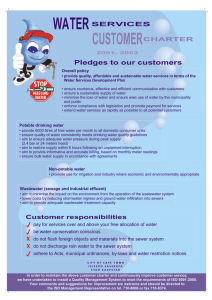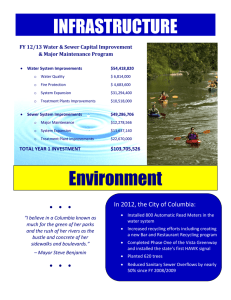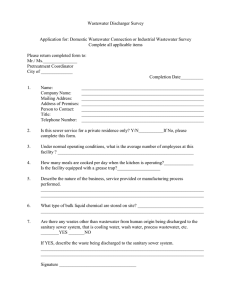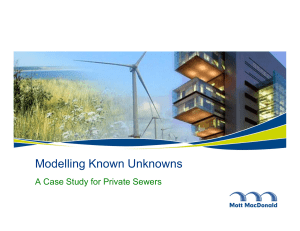prevention is better than cure – do low i/i sewers really work
advertisement
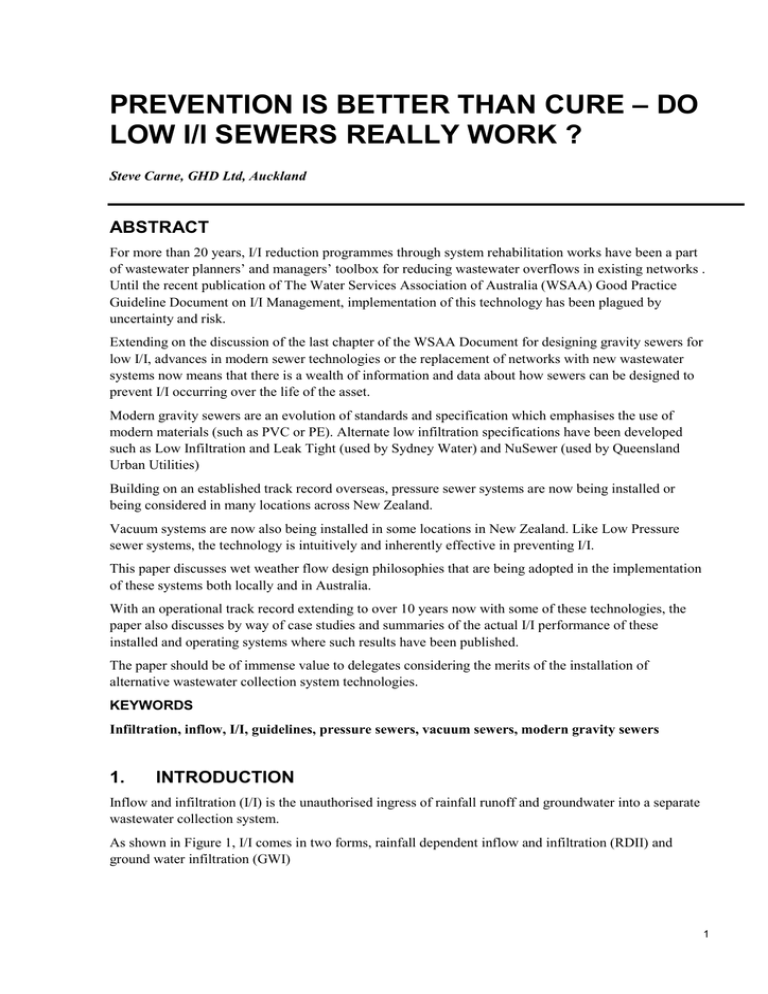
PREVENTION IS BETTER THAN CURE – DO LOW I/I SEWERS REALLY WORK ? Steve Carne, GHD Ltd, Auckland ABSTRACT For more than 20 years, I/I reduction programmes through system rehabilitation works have been a part of wastewater planners’ and managers’ toolbox for reducing wastewater overflows in existing networks . Until the recent publication of The Water Services Association of Australia (WSAA) Good Practice Guideline Document on I/I Management, implementation of this technology has been plagued by uncertainty and risk. Extending on the discussion of the last chapter of the WSAA Document for designing gravity sewers for low I/I, advances in modern sewer technologies or the replacement of networks with new wastewater systems now means that there is a wealth of information and data about how sewers can be designed to prevent I/I occurring over the life of the asset. Modern gravity sewers are an evolution of standards and specification which emphasises the use of modern materials (such as PVC or PE). Alternate low infiltration specifications have been developed such as Low Infiltration and Leak Tight (used by Sydney Water) and NuSewer (used by Queensland Urban Utilities) Building on an established track record overseas, pressure sewer systems are now being installed or being considered in many locations across New Zealand. Vacuum systems are now also being installed in some locations in New Zealand. Like Low Pressure sewer systems, the technology is intuitively and inherently effective in preventing I/I. This paper discusses wet weather flow design philosophies that are being adopted in the implementation of these systems both locally and in Australia. With an operational track record extending to over 10 years now with some of these technologies, the paper also discusses by way of case studies and summaries of the actual I/I performance of these installed and operating systems where such results have been published. The paper should be of immense value to delegates considering the merits of the installation of alternative wastewater collection system technologies. KEYWORDS Infiltration, inflow, I/I, guidelines, pressure sewers, vacuum sewers, modern gravity sewers 1. INTRODUCTION Inflow and infiltration (I/I) is the unauthorised ingress of rainfall runoff and groundwater into a separate wastewater collection system. As shown in Figure 1, I/I comes in two forms, rainfall dependent inflow and infiltration (RDII) and ground water infiltration (GWI) 1 Figure 1: Sample I/I Flow Components (WSAA Wastewater System Inflow/Infiltration Management Good Practice Guideline Document) Rainfall dependent inflow and infiltration is due to runoff during and after a rainfall event entering the system through illegally or erroneously connected impermeable areas and through defects such as cracks in both sewers and in house laterals. Ground water infiltration is generally considered constant but can change seasonally in response to water table movement or tidal changes in coastal areas. I/I can cause stress on the sewerage system in a number of ways that can result in problems such as: Overflows during rainfall events when the capacity of the collection system is exceeded.; Adverse effects on treatment plant processes and exceeding discharge consents. 2. THE CURE – RECENT DEVELOPMENTS IN I/I REDUCTION PRACTICE For more than 20 years, I/I reduction programmes through system rehabilitation works have been a part of wastewater planners’ and managers’ toolbox for reducing wastewater overflows. Until recently, though, implementation of the technology has been plagued by uncertainties in outcomes from investments in rehabilitation programmes. In response to the evolving market need of its member organisations, The Water Services Association of Australia (WSAA) engaged GHD (in association with local consulting partner Urban Water Solutions (UWS)) to develop a Good Practice Guideline Document on I/I Management. Carried out in two stages of work, the project outputs define both theory and practice of good I/I management. Analysis of a significant number of projects has shown there is now a robust knowledge base to make far more reliable and informed predictive estimates of I/I reduction levels that will be achieved from varying levels of system rehabilitation. The work gives wastewater planners and managers a far more robust basis to undertake I/I reduction programmes through system rehabilitation with the expectation of certain outcomes for a given financial investment. This is considered to be a significant global advancement in the planning of wastewater system improvement and management programmes. The work defined a number of parameters in establishing best practice: 2 Establishment of a common understanding of current I/I performance and management processes across the participating WSAA member organisations; Benchmarking of practices between those used in Australia, New Zealand, the USA and other jurisdictions; Definition and adoption of a consistent set of I/I key performance indicators and provision of a set of standardised calculation routines for these. Threshold values for these parameters, below which it is not considered cost effective to undertake system rehabilitation to achieve I/I reduction. Other overflow mitigation techniques based around enhanced conveyance or detention storage are considered more suitable in such cases. Definition of a five-step process, which if followed rigorously, will most likely result in reduction outcomes consistent with the most successful programmes completed in these jurisdictions; Information on processes associated with saline groundwater or seawater infiltration reduction. That approximately half the removable I/I getting into a system comes through the private laterals and that not addressing private lateral I/I will severely limit I/I reduction outcomes. Guidance on how to reduce I/I from private laterals, including the vexatious issue of who pays. Guidelines on likely I/I reduction levels that can be achieved when various levels of rehabilitation are undertaken. These guidelines are based on the results of analysed projects across New Zealand, Australia and the United States. The guidelines suggest that up to 85% of I/I is removable when the entire system is rehabilitated up to the gully trap at the house, but only 50% is removable if only the public system is rehabilitated. An overview of appropriate I/I source detection and system rehabilitation techniques currently available in the market and guidelines on unit cost estimating rates for these. An overview of new technologies, specifications and post-construction inspection and approvals processes now available and possible in Australia for the design and construction of new gravity wastewater collection systems that are aimed to prevent I/I occurring in the future over the life of the asset. 2.1 NZ I/I CONTROL MANUAL – NEW EDITION It is noted that the time of authorship of this paper, WaterNZ had just engaged GHD to prepare an update/rewrite of the 1996 New Zealand Inflow and Infiltration Control Manual. This project is scheduled to be completed in November 2014 and aims to not only draw on the WSAA material and experience and but to develop a similar guideline document for use by New Zealand wastewater system managers based on their defined needs. 3. PREVENTION – DESIGNING NEW LOW I/I SEWERS Extending on the discussion of this last chapter of the WSAA Guideline Document for designing gravity sewers for low I/I, advances in modern sewer technologies, replacement of networks with new wastewater systems can effectively exclude or significantly reduce I/I. Advances in standards, systems and technologies have seen alternative wastewater collection system technologies advance significantly in reliability, acceptance and reductions in cost (both capital and operational and maintenance). 3.1 MODERN GRAVITY SEWER Modern gravity sewers are an evolution of standards and specification which emphasises the use of modern materials (such as PVC or PE). Alternate low infiltration specifications have been developed 3 such as Low Infiltration and Leak Tight (used by Sydney Water) and NuSewer (used by Queensland Urban Utilities) systems. These specifications are available on-line. The Low Infiltration Sewer specification focusses on PVC materials whilst the Leak Tight Specification focusses on PE materials. All of these systems have the specific aims to: To provide a sealed system capable of avoiding root intrusion and stormwater infiltration; To eliminate or minimise the need for personnel entry into confined space maintenance holes. For all technologies, utilising modern pipe materials and methodologies for construction, operation and maintenance in the design of a sewer system, one is able to reduce the opportunities for stormwater/groundwater to enter the pipe network. Plastic pipes (PE/PVC) allow fully sealed connections and are flexible to resist cracking. Modern maintenance techniques have eliminated much of the need for concrete manholes, limiting the requirement for confined space entries. Fewer manholes are required, and those that are can be installed in low I/I materials such as small diameter maintenance shafts. Eliminating concrete manholes provides benefits of reduced capital cost, future maintenance requirements, and increased public safety with no manhole lids to be displaced. The Low Infiltration and Leak Tight Sewer Specifications published by Sydney Water recommend designing systems using hydraulic modelling assuming totals of 2% and 1% rainfall total ingress respectively. This is significantly less than normally accepted empirical design formulas which recommend peak wet weather flows be based on 5 times average dry weather flow. Sydney Water are currently assessing the I/I performance of installed Leak Tight and Low I/I specified systems. Results are encouraging and are validating the specification of low I/I design parameters. 3.2 PRESSURE SEWERS Building on an established track record overseas, pressure sewer systems are now being installed or being considered in many locations across New Zealand. In addition to its attributes of being well suited to areas of high water table, flat or low lying ground or steep and rocky ground, pressure sewer is also inherently effective at the exclusion of I/I. Significant experience and capability is now available in the New Zealand water industry for the investigation, design, construction and delivery of pressure sewer projects. Having solid knowledge of the level of on property I/I w can be expected when servicing existing residential catchments is key when pressure sewer systems are retrofitted to existing towns or villages. In the design of Low Pressure systems, common practice is that wet weather peaking factors for the design of greenfields systems are minimal. Peaking factors of 1.2 on normal dry weather flows are usually applied for retrofitted systems to conservatively cater for possible I/I sources upstream of the gully traps. This also is significantly less than normally accepted empirical design formulas. 3.3 VACUUM SEWERS Vacuum systems are now also being installed in some locations in New Zealand.. Vacuum systems offer the assets owner a number of advantages, particularly around the ability to place assets in the public road reserve and not on private property, and around orders of scale, with a single vacuum pump station being able to serve larger numbers of properties, within the constraints of a vacuum system i.e. topography and maximum lift. In the design of Vacuum Systems, wet weather peaking factors of 1.2 of normal dry weather flows have been allowed for. This also is significantly less than normally accepted empirical design formulas for gravity sewers. 4 4. IMPLEMENTATION AND I/I PERFORMANCE OUTCOMES 4.1 MODERN GRAVITY SYSTEMS Sydney Water now specify that all new greenfield developments are installed using either the Leak Tight or Low I/I Sewer specifications. Sydney Water have advised that whilst there is an indication of improved performance in terms of inflow and infiltration, there isn’t as yet enough development or information available to make definitive statements about performance of these systems. It is understood that the WSAA Sewerage Design Codes will be shortly be revised to include the specification of Leak Tight and Low Infiltration type sewers. 4.2 PRESSURE SEWERS Pressure sewers have been are being installed at several locations throughout New Zealand. Known locations include • • • • • new greenfield subdivisional developments north of Auckland in the Orewa area backlog programs to serve existing growth in and also new developments in the towns of Kumeu, Huapai and Riverhead various existing villages as backlog programs around Lake Rotorua several catchments in suburban Christchurch as part of the SCIRT rebuild as well as the outlying settlements of Charteris Bay and Wainui within the CCC area Backlog programs to serve existing towns at Opua and Awanui in the Far North, Himatangi Beach in Manawatu District, Maketu and other coastal communities in the Western Bay of Plenty District. There may be others unknown to the author. In Australia, communications undertaken during the research carried out for the preparation of this paper identified that pressure sewers were being used extensively for in both backlog programs to serve existing residential developments and also greenfield areas at the following water companies • • • South East Water in Melbourne. The first of these systems was installed in the Westernport area nearly 10 years ago and more recently, SEW are relying on pressure sewer technology in completing the backlog sewer program on the Mornington Peninsula. Yarra Valley Water in Melbourne in new greenfield area in the far east of Melbourne. Sydney Water in new greenfield areas. Pressure sewers have been installed and operating in the USA for over 30 years. Limited data is available on the operational track record relating to I/I of the New Zealand systems. There are no reported cases of increase in flows during wet weather. I/I has been recorded in some systems where the old private house lateral drain to the septic tank was retained as part of the lateral that drains to the pressure sewer pump pit. These have had to be repaired to remove this I/I. In any case, whilst there are no known recorded cases of it happening, it is possible that property owners could still connect stormwater inflow defects directly to the private house lateral. The disincentive to do this is that the property owner have to pay for the additional pumping costs associated with the inflow volumes. 5 Analysis carried out by SEW in Melbourne indicates that even after 10 years of operation, there is still no significant wet weather response in their pressure sewer systems. Flow monitoring done to date on these systems indicates very little or non-existent wet weather response. Evan though pressure sewer systems have been implemented there for over 30 years, local New Zealand suppliers of pressure sewer technologies could not identify any cases where I/I operational performance assessment of pressure sewers using their technologies in the USA had been carried out. 4.3 VACUUM SEWERS The largest known installed vacuum sewer system in New Zealand is at Kawakawa Bay in Auckland. This system serves approximately 200 houses and was commissioned in 2012. Other vacuum systems are being considered for and being installed in Christchurch as part of SCIRT. As yet, no advice on operational history from either of these systems is available. In Melbourne, City West Water (CWW) have a large vacuum-gravity hybrid sewer system serving over 2000 properties at Sanctuary Lakes in the Point Cook area in Melbourne’s south west. This system was installed in the period 2002-2004 in an area with a very shallow water table. Increases in flows during wet weather in this system have been recorded and some analysis has been carried out. It has not been determined whether the flow increases have come from the gravity or vacuum sewer part so the network. CWW have observed a close correlation of between flow increases with actual rainfall events. Such increases in flow are not apparent when rain is not present indicating groundwater infiltration outside of rainfall events is not the cause of the issue. Given this absence of groundwater infiltration, intuitively, in the absence of any other information, it is the author’s perception that a gravity system is more likely to be subject to rainfall dependent infiltration and the cause of the wet weather flow increase rather than the vacuum system. 5. CONCLUSIONS 1. Modern Gravity, Pressure Sewers and Vacuum Sewers all feature a range of measures which when correctly implemented, should result in significantly reduced potential for or the total elimination of inflow and infiltration in sewers. 2. The types of technologies now being implemented in new systems and as part of backlog systems in New Zealand has increased significantly and now includes versions and variants of all of the technologies investigated here. 3. In Backlog applications, whether the existing drains to septic tanks are used or not used as part of the long term private house lateral is considered an important in ensuring that I/I is eliminated from the system. 4. Whilst there are initial indications and anecdotal evidence that such technologies have reduced or eliminated I/I in wastewater systems, there is currently little published information available on the actual I/I performance of the different technologies after some years of operation. 5. Indications are that more formal assessments of I/I performance of these systems are being or are about to be carried out by some agencies eg South East Water and Sydney Water and that this information may soon become apparent in the near future. 6 6. It is considered prudent that New Zealand water agencies should keep abreast of the development of such information in consideration of the implementation and adoption of such technologies. 7
